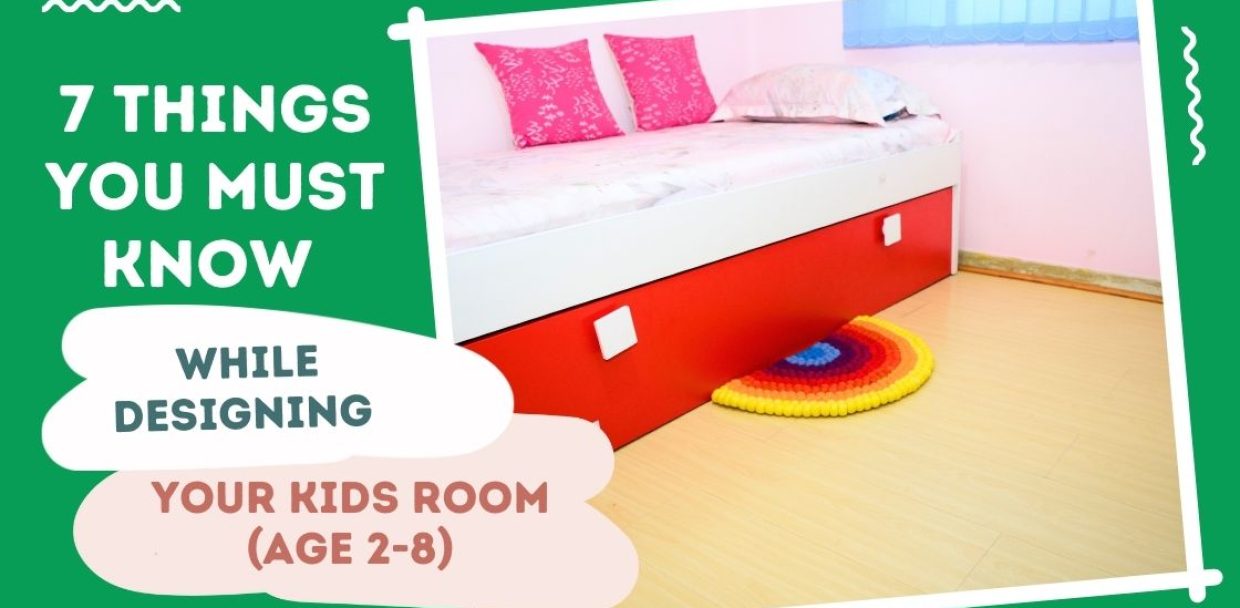Designing a kid’s room is quite a rewarding task. After all, it’s where your little one will spend significant time playing, learning, and growing.
However, if you’re thinking of designing a room for younger children between the ages of 2-6, there are a few key considerations that you need to keep in mind.
Apart from the things like keeping a safe environment and preventing injuries, it is important to create a space that fosters creativity and imagination. So, before you begin, make sure to read this list of things you can’t forget while designing your baby’s room.
These seven tips might seem obvious, but combined will help you design a delightful and functional space for your young child.
Prioritize Safety
Safety should always be the number one concern when designing a room for young children. Here are some essential safety tips to keep in mind:
- Securely fasten furniture, fixtures, and decorations to the walls: Use brackets or wall anchors to prevent tipping accidents. This is especially important for bookshelves, dressers, and other tall furniture items kids try climbing on.
- Cover electrical outlets: Use outlet covers or safety plugs to prevent little fingers from contacting electrical sockets.
- Choose cordless window coverings: Cords from blinds or curtains can pose a strangulation hazard. Opt for cordless blinds or install safety devices to keep cords out of reach.
- Select non-toxic materials: When choosing furniture and toys, ensure they are made from non-toxic materials. Look for certifications or labels that indicate low levels of harmful chemicals.
- Keep small objects out of reach: Small objects can be choking hazards for young children. Be mindful of toys, accessories, and any small parts that can be easily swallowed. Regularly inspect the room to ensure there are no small objects within reach.
Optimize Storage
Babies, toddlers, and younger kids come with many things, from toys and clothes to diapers and books. You need to add a few adequate storage solutions that are essential to keep the room organized and maintain a clutter-free space.
- Open Shelves: Add a few open shelves in your child’s room. They are perfect for displaying books, toys, and decorative items. Your little one can easily see and access their favorite things, fostering independence and a sense of ownership.
- Toy Bins: Invest in sturdy and spacious toy bins or boxes. These are great for gathering and storing various toys in one place. You can even have different bins for different types of toys, making it easier for your child to find what they’re looking for during playtime.
- Baskets: Use baskets to store soft toys, blankets, and stuffed animals. Baskets are not only practical but also add a touch of charm to the room’s decor. You can place them on shelves or in corners, creating cozy nooks for your child’s favorite companions.
- Labeled Containers: Make tidying up a breeze by using labeled containers. Attach colorful labels to toy bins, drawers, or shelves, indicating the contents inside. This helps your child develop organizational skills and makes sorting and putting away their belongings fun.
- Involve Your Child: As your child grows older, involve them in the tidying process. Teach them how to put their toys back in their designated spots and encourage them to participate in keeping the room clean. Make it a fun activity by turning it into a game or setting a timer for a quick cleanup challenge.
Create a Calming Atmosphere
Babies and young children benefit by staying in calmer environments. A quiet and calm space even helps them relax and sleep better. So, you need to consider creating such an atmosphere while designing their room.
Here are a few tips to create a serene atmosphere in your child’s room:
- Color Palette: Go for soft and neutral colors for the walls, such as pastel shades of blue, green, or pink. These colors have a calming effect and make a peaceful ambiance in the room.
- Gentle Lighting: Consider incorporating dimmers or nightlights in the room that allow you to adjust the intensity of the light during bedtime routines. Nightlights provide a soft glow that can comfort your child if they wake up during the night.
- Light Control: Install blackout curtains or blinds to regulate the amount of natural light entering the room, especially during naps. This small consideration helps promote better sleep for your little one.
- Bonding Space: Introduce a comfortable rocking chair or a cozy reading nook in the room. A place where you can spend quality time with your child (e.g., storytelling before bedtime) is the best place got connection and bonding.
These elements in your child’s room will help create a peaceful environment promoting relaxation and rest.
Stimulate the Senses
Engaging your child’s senses is fun and essential for their cognitive development. Here are a few tips:
Textures, Colors & Patterns: Introduce a variety of textures throughout the room, like soft and cozy fabrics for bedding and rugs, or a fuzzy blanket, a fluffy rug, or a plush toy to enhance their sense of touch. Play with colors to stimulate your child’s visual senses.
Opt for a vibrant and playful color palette that captures their imagination. You can use colorful wall decals, vibrant curtains, or brightly painted furniture. Also, look to add geometric shapes, stripes, polka dots, or even animal prints throughout the room. You can use patterned wallpaper, bedding, or curtains to create an engaging and dynamic space.
But remember to choose soothing and not overly stimulating colors for bedtime.
Wall Murals and Decals: Do a DIY project with your kid and turn a plain wall into a captivating canvas by adding a wall mural or decals. Choose designs that reflect your child’s interests, such as animals, nature scenes, or their favorite characters. This adds visual appeal and sparks their imagination and storytelling skills.
Mobiles in Motion: Hang a colorful mobile above your child’s crib or play area. Mobiles with various shapes, colors, and dangling objects provide visual stimulation and encourage your little one to focus and track moving objects. A mobile’s gentle movements and soothing music can also create a calming atmosphere during naptime or bedtime.
Soft Toys for Comfort: Plush toys, stuffed animals, and dolls can provide your child with a comforting and cuddly sensory experience. Choose toys with different textures and materials to encourage exploration and sensory play.
Musical Instruments for Rhythmic Fun: Include age-appropriate instruments such as drums, xylophones, or shakers that allow your child to explore sound and rhythm. Musical activities promote auditory stimulation, coordination, and creative expression.
Encourage Creativity and Play
Children learn and explore through play. Design a space that fosters creativity and imagination by incorporating areas for different types of play. Here are some ideas to create different play areas within the room:
Art Corner: Set up a special area with a small table and chairs where your child can unleash their creativity. Stock it with crayons, washable paints, and plenty of paper. Also, you can display their doodles and scribbles on the walls to showcase their talent and boost their confidence.
Reading Nook: Create a cozy and inviting space for your child to curl up with their favorite books. Place a soft bean bag chair or a comfy cushion in a corner, along with a low bookshelf filled with age-appropriate books.
Imaginative Play: Spark your child’s imagination by incorporating a play kitchen or tent in the room. A play kitchen allows them to pretend to cook and serve imaginary meals, while a tent can transform into a magical hideout or a camping adventure.
Sensory Play Area: Set aside a space for sensory play, which engages your child’s senses and enhances their cognitive development. You can include a sensory table filled with materials like colored rice, sand, or water for tactile exploration. Add sensory bins with different textures, such as buttons, pom-poms, or feathers, for your child to touch and manipulate.
Building and Construction Zone: Set up a low table or a play mat with building blocks, Legos, or magnetic tiles. This promotes fine motor skills, problem-solving, and spatial awareness as they construct towers, houses, or imaginative structures.
Flexibility for Growth
Designing a room that can adapt to your child’s changing needs is essential to avoid frequent overhauls.
Convertible Cribs: Going for a convertible crib that can transform into a toddler bed will allow a smooth transition as your child graduates from the crib stage. It eliminates the need to purchase a separate bed, saving money and easy adjustment for your kid.
Adjustable Shelving Units: Invest in shelving units that can be adjusted as your child grows taller and their storage needs change. These flexible shelves can accommodate different-sized toys, books, and display items, making it easier to keep the room organized.
Flexible Seating Options: Bean bags, floor cushions, or modular seating arrangements allow for comfortable seating during playtime, storytime, or even as they get older and need a spot to relax or read independently.
Adaptable Desks and Tables: Consider desks and tables that can be adjusted in height to accommodate various tasks, such as drawing, writing, and crafts. This ensures ergonomic support and promotes good posture as they engage in different activities.
By incorporating these adaptable design elements, you can create a room that evolves alongside your child’s needs, saving you from frequent redesigns and additional expenses.
Personalize the Space
Lastly, involving your child in the design process is a fantastic way to make the room truly theirs.
Let them choose colors: Ask your child what colors they like and involve them in selecting the paint color for the walls. They might prefer vibrant and bold shades or calm and soothing tones.
Explore themes: Talk to your child about their favorite themes, such as animals, space, or superheroes. Incorporate these themes into the room’s decor through bedding, wall decals, or artwork.
Favorite characters: If your child has beloved characters from books, movies, or cartoons, consider incorporating them into the room’s design. Bedding, curtains, or even a fun poster can bring their favorite characters to life.
Personalized name or initials: Add a personal touch by incorporating your child’s name or initials into the room’s decor. You can use wooden letters, vinyl decals, or even have a customized nameplate on the door.
Favorite toys or collections: If your child has a special toy or collection, find a way to incorporate it into the room’s design. Whether it’s displaying their favorite stuffed animals on a shelf or creating a dedicated space for their toy cars, including their cherished items will make the room feel extra special.
Conclusion
Designing a room for children aged 2 to 6 involves prioritizing safety, optimizing storage, creating a calming atmosphere, engaging the senses, providing spaces for play and imagination, ensuring flexibility as they grow, and personalizing the space.
By considering these 7 things while designing your kid’s room, you’ll ensure this space fosters growth, creativity, and joy for your child. Remember to adapt the room as they grow to maintain a comfortable and inspiring environment throughout their early years.
Disclaimer: The tips provided in this article are for general guidance purposes only and should not replace professional advice. Readers are encouraged to use their discretion and consult relevant experts for personalized recommendations regarding room design and safety.




